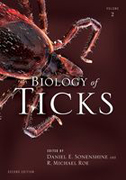
The most comprehensive work on tick biology and tick-borne diseases Multi-authored work offers a diverse and truly international perspective This second volume covers tick ecology, genetics and genomics, tick-borne diseases, tick control and rearing tick colonies for experimental study Biology of Ticks is the most comprehensive work on tick biology and tick-borne diseases. This second edition is a multi-authored work, featuring the research and analyses of renowned experts across the globe. Spanning two volumes, the book examines the systematics, biology, structure, ecological adaptations, evolution, genomics and the molecular processes that underpin the growth, development and survival of these important disease-transmitting parasites. Also discussed is the remarkable array of diseases transmitted (or caused) by ticks, as well as modern methods for their control. This book should serve as a modern reference for students, scientists, physicians, veterinarians and other specialists. Volume I covers the biology of the tick and features chapters on tick systematics, tick life cycles, external and internal anatomy, and others dedicated to specific organ systems, specifically, the tick integument, mouthparts and digestive system, salivary glands, waste removal, salivary glands, respiratory system, circulatory system and hemolymph, fat body, the nervous and sensory systems and reproductive systems. Volume II includes chapters on the ecology of non-nidicolous and nidicolous ticks, genetics and genomics (including the genome of the Lyme disease vector Ixodes scapularis) and immunity, including host immune responses to tick feeding and tick-host interactions, as well as the tick's innate immune system that prevents and/or controls microbial infections. Six chapters cover in depth the many diseases caused by the major tick-borne pathogens, including tick-borne protozoa, viruses, rickettsiae of all types, other types of bacteria (e.g., the Lyme disease agent) and diseases related to tick paralytic agents and toxins. The remaining chapters are devoted to tick control using vaccines, acaricides, repellents, biocontrol, and, finally, techniques for breeding ticks in order to develop tick colonies for scientific study. Readership: University faculty in health sciences, biological sciences, entomology, acarology; veterinarians, physicians, public health officials, and government research centers.
- ISBN: 978-0-19-974406-0
- Editorial: OXFORD UNIVERSITY PRESS.
- Encuadernacion: Tela
- Páginas: 544
- Fecha Publicación: 09/01/2014
- Nº Volúmenes: 1
- Idioma:
